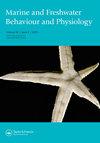Switching between swimming states in rotifers – case study Keratella cochlearis
IF 1.1
4区 生物学
Q3 MARINE & FRESHWATER BIOLOGY
Marine and Freshwater Behaviour and Physiology
Pub Date : 2018-05-04
DOI:10.1080/10236244.2018.1503541
引用次数: 10
Abstract
ABSTRACT Swimming is of vital importance for aquatic organisms because it determines several aspects of fitness, such as encounter rates with food, predators, and mates. Generally, rotifer swimming speed is measured by manual tracking of the swimming paths filmed in videos. Recently, an open-source package has been developed that integrates different open-source software and allows direct processing and analysis of the swimming paths of moving organisms. Here, we filmed groups of females and males of Keratella cochlearis separately and in a mixed experimental setup. We extracted movement trajectories and swimming speeds and applied the classification method random forest to assign sex to individuals of the mixed setup. Finally, we used advanced statistical methods of movement ecology, namely a hidden Markov model, to investigate swimming states of females and males. When not discriminating swimming states, females swam faster than males, while when discriminating states males swam faster. Specifically, females and males showed two main states of movement with many individuals switching between states resulting in four modes of swimming. We suggest that switching between states is related to predator avoidance. Males of K. cochlearis especially exhibited switching between turning in a restricted area and swimming over longer distances. No mating or other male–female interactions were observed. Our study elucidates the steps necessary for automatic analysis of rotifer trajectories with open-source software. Application of sophisticated software and analytical models will broaden our understanding of zooplankton ecology from the individual to the population level.轮虫在游泳状态间的转换——耳蜗角虫的个案研究
游泳对水生生物至关重要,因为它决定了几个方面的适应性,如与食物、捕食者和配偶的相遇率。一般来说,轮虫的游泳速度是通过人工跟踪视频中拍摄的游泳路径来测量的。最近,一个开源软件包已经开发出来,它集成了不同的开源软件,可以直接处理和分析移动生物的游动路径。在这里,我们分别拍摄了雌性和雄性耳蜗角虫组,并在混合实验装置中进行了拍摄。我们提取运动轨迹和游泳速度,并应用随机森林分类方法对混合设置的个体进行性别分配。最后,我们使用运动生态学的先进统计方法,即隐马尔可夫模型,来研究雌性和雄性的游泳状态。在不区分游泳状态下,女性游得比男性快,而在区分状态下,男性游得比女性快。具体来说,雌性和雄性表现出两种主要的运动状态,许多个体在状态之间切换,从而产生了四种游泳模式。我们认为状态之间的切换与捕食者的躲避有关。雄性耳蜗孔雀鱼尤其表现出在受限区域转弯和长距离游泳之间的切换。没有观察到交配或其他雄性与雌性的互动。我们的研究阐明了用开源软件自动分析轮虫轨迹所需的步骤。复杂的软件和分析模型的应用将扩大我们对浮游动物生态学的理解,从个体水平到种群水平。
本文章由计算机程序翻译,如有差异,请以英文原文为准。
求助全文
约1分钟内获得全文
求助全文
来源期刊

Marine and Freshwater Behaviour and Physiology
生物-海洋与淡水生物学
CiteScore
2.10
自引率
0.00%
发文量
9
审稿时长
>12 weeks
期刊介绍:
Marine and Freshwater Behaviour and Physiology is devoted to the publication of papers covering field and laboratory research into all aspects of the behaviour and physiology of all marine and freshwater animals within the contexts of ecology, evolution and conservation.
As the living resources of the world’s oceans, rivers and lakes are attracting increasing attention as food sources for humans and for their role in global ecology, the journal will also publish the results of research in the areas of fisheries biology and technology where the behaviour and physiology described have clear links to the contexts mentioned above.
The journal will accept for publication Research Articles, Reviews, Rapid Communications and Technical Notes (see Instructions for authors for details). In addition, Editorials, Opinions and Book Reviews (invited and suggested) will also occasionally be published. Suggestions to the Editor-In-Chief for Special Issues are encouraged and will be considered on an ad hoc basis.
With the goal of supporting early career researchers, the journal particularly invites submissions from graduate students and post-doctoral researchers. In addition to recognising the time constraints and logistical limitations their research often faces, and their particular need for a prompt review process, accepted articles by such researchers will be given prominence within the journal (see Instructions for authors for details).
 求助内容:
求助内容: 应助结果提醒方式:
应助结果提醒方式:


